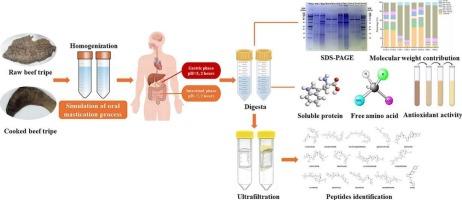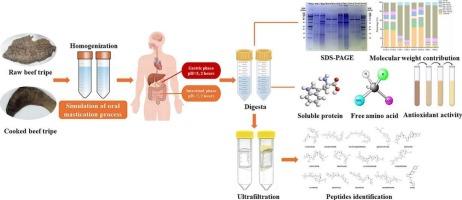蒸煮处理对牛肚体外胃肠消化过程中蛋白质消化率、肽谱及潜在生物活性肽的影响
IF 9.8
1区 农林科学
Q1 CHEMISTRY, APPLIED
引用次数: 0
摘要
本研究的目的是通过体外胃肠模型了解烹饪处理对牛肚蛋白水解和潜在生物活性肽释放的影响。结果表明,消化促进了牛肚中蛋白质的水解和游离氨基酸的释放,而蒸煮处理则显著降低了这一过程。经消化道消化后的牛肚样品抗氧化活性最高。对胃肠道食糜进行了肽组学和计算机分析,以确定具有生物活性的抗氧化肽序列。共鉴定出14个多肽,其结构特征证实具有抗氧化作用以及一系列其他生物学功能,如血管紧张素i转换酶(ACE)和二肽基肽酶IV (DPP-IV)抑制活性。上述结果表明,牛肚及其消化产物具有促进健康的潜力,可作为功能性食品的原料加以利用。本文章由计算机程序翻译,如有差异,请以英文原文为准。


Effect of cooking treatment on protein digestibility, peptide profile and potential bioactive peptides of beef tripe during in vitro gastrointestinal digestion
The purpose of this study was to understand the effects of cooking treatment on the protein hydrolysis of beef tripe and the release of potentially bioactive peptides using an in vitro gastrointestinal model. The results showed that digestion promoted the hydrolysis of proteins and release of free amino acids in beef tripe, but cooking treatment significantly reduced them. The sample of the cooked beef tripe after gastrointestinal digestion had the highest antioxidant activity. Peptidomic and in silico analyses of gastrointestinal digesta were performed to identify bioactive antioxidant peptide sequences. A total of 14 peptides were identified, which were confirmed with structural characteristics to exhibit antioxidation effects as well as a range of other biological functions, such as angiotensin I-converting enzyme (ACE) and dipeptidyl peptidase IV (DPP-IV) inhibitory activities. These findings indicate that beef tripe and its digestive products have health-promoting potential, which can be utilized in functional food as ingredients.
求助全文
通过发布文献求助,成功后即可免费获取论文全文。
去求助
来源期刊

Food Chemistry
工程技术-食品科技
CiteScore
16.30
自引率
10.20%
发文量
3130
审稿时长
122 days
期刊介绍:
Food Chemistry publishes original research papers dealing with the advancement of the chemistry and biochemistry of foods or the analytical methods/ approach used. All papers should focus on the novelty of the research carried out.
 求助内容:
求助内容: 应助结果提醒方式:
应助结果提醒方式:


